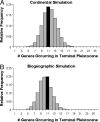Synchronous extinction of North America's Pleistocene mammals
- PMID: 19934040
- PMCID: PMC2791611
- DOI: 10.1073/pnas.0908153106
Synchronous extinction of North America's Pleistocene mammals
Abstract
The late Pleistocene witnessed the extinction of 35 genera of North American mammals. The last appearance dates of 16 of these genera securely fall between 12,000 and 10,000 radiocarbon years ago (approximately 13,800-11,400 calendar years B.P.), although whether the absence of fossil occurrences for the remaining 19 genera from this time interval is the result of sampling error or temporally staggered extinctions is unclear. Analysis of the chronology of extinctions suggests that sampling error can explain the absence of terminal Pleistocene last appearance dates for the remaining 19 genera. The extinction chronology of North American Pleistocene mammals therefore can be characterized as a synchronous event that took place 12,000-10,000 radiocarbon years B.P. Results favor an extinction mechanism that is capable of wiping out up to 35 genera across a continent in a geologic instant.
Conflict of interest statement
The authors declare no conflict of interest.
Figures



References
-
- Martin PS, Klein RG. Quaternary Extinctions: A Prehistoric Revolution. Tucson, AZ: Univ of Arizona Press; 1984.
-
- MacPhee RDE. Extinctions in Near Time: Causes, Contexts, and Consequences. New York: Kluwer/Plenum; 1999.
-
- Barnosky AD, Koch PL, Feranec RS, Wing SL, Shabel AB. Assessing the causes of late Pleistocene extinctions on the continents. Science. 2004;306:70–75. - PubMed
-
- Koch PL, Barnosky AD. Late Quaternary extinctions: State of the debate. Annu Rev Ecol Evol Syst. 2006;37:215–250.
-
- Haynes G. American Megafaunal Extinctions at the End of the Pleistocene. Dordecht, The Netherlands: Springer; 2009.
MeSH terms
LinkOut - more resources
Full Text Sources

